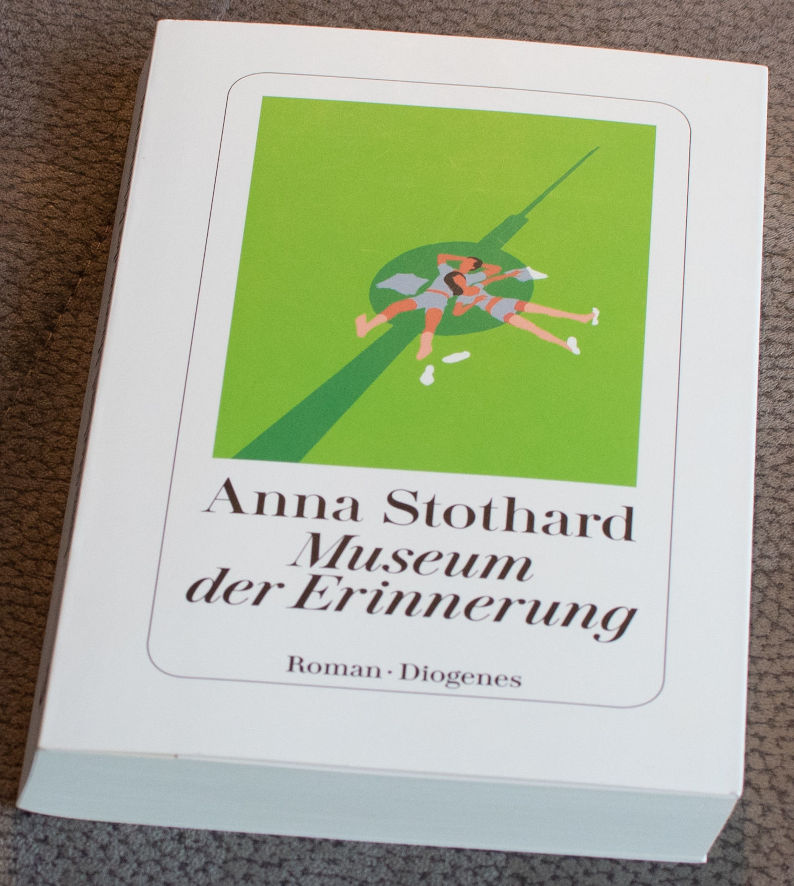A museum thriller
A friend who knows me very well lent me this book recently: Museum der Erinnerung, that is, Museum of Memory, by Anna Stothard. (Thanks Anne!)
I liked it a lot and even made a video book review about it. Check it out! Below is the transcript and, at the bottom, some links for you to explore to your heart’s desire. Enjoyyyy!
A story of two titles, two covers
The original English title is actually The Museum of Cathy, named after the protagonist – which is much more nuanced and suited to the story. I’ll come back to that. The English cover design also much more aligned with the story; the Diogenes cover shows a scene that not only never happens in the book, but has a relaxed atmosphere that is definitely not in this story.
What's it about?
So much for judging a book by its cover. What’s it about?
The book opens in the Natural History Museum in Berlin, one of my favorite museums.
The fictional protagonist, Cathy, works here as a specialist in insects and especially moths. She pins moths into boxes to preserve them for researchers and museum visitors. Her fiance works in the same museum – which I will say as a museum person, is a highly rare and enviable position for a couple working in the same field. Anyway we learn in the first pages how devoted Tom is to Cathy, bringing her coffee at her desk and generally being googly-eyed over her.
Gradually though we learn about Cathy’s dark history, revealed in flashback-like vignettes interspersed with the “now” time in the natural history museum.
Cathy grew up on a damp, salty, windswept part of the British coast that sounds about as forlorn and isolated as you can imagine. But Cathy loves it for the treasures of nature she can collect there as a kid. She is a collector, even a hoarder, of seashells, feathers, skulls and bones.
This tendency grows stronger through personal traumas that make Cathy’s life so painful, she seeks solace in her objects. I won’t tell you any spoilers, so I’ll just say that she is trapped in multiple abusive relationships and suffers numerous tragedies that exacerbate her hoarding, and expand it from natural things to personal things as well: toy soldiers, as on the book cover, scraps of newspaper articles, and sketches. Also miniature gin bottles and human teeth. Like I said, dark.
Big plus, small minus
That’s the basic picture. Here are my thoughts about this book:
Generally it’s successful. I read the first half in about a day and was eager to go back to it on the following evenings; it has a sort of thriller element as you uncover more and more of Cathy’s history, and how it connects to the present. This was compelling.
I’m going to get my minor complaint out of the way briefly: both Cathy’s delicate appearance (translucent white skin, surprisingly blue eyes) and her secretive personality, the way she doesn’t tell her fiance a single thing about her life, are fetishized in a way that got on my nerves after a while. When I saw the picture of the author who herself has eyes that might be described as “surprisingly blue” I thought, ah, of course there’s autobiography in everything an author writes. Confirmed by the author’s self description on her website as a “hoarder.”
I guess I also wish the author had had a friend from Berlin check the story for accuracy. No real Berliner ever seriously worries that they will be stared at in public because of what they are wearing. It just doesn’t happen.
The soul of museums
Now about the museum aspect.
I like the way Berlin’s museum of natural history plays a big role in the story. It’s not just a backdrop: its labyrinthine hallways, cavernous galleries, and countless exhibits are given a lot of love and attention. The story occupies the museum like a body, inhabiting it completely and activating all its parts.
This is why discovering the English title of the book was such a revelation for me: it makes so. much. sense. to think of Cathy’s collection as her private museum ABOUT HERSELF. It’s not just a collection of memories, the way the German title implies: it’s HER represented in objects.
This is a really cool idea to contemplate for all of us: to what extent do our objects define us? If you were to choose just enough objects to fit in a shoebox that were going to be your Museum of You, what would they be? How complete of a picture can they make? Probably not 100% complete, but perhaps metaphorically, symbolically representative nonetheless. Or not – maybe the shortcomings of what objects can represent becomes painfully obvious.
Now take that idea and apply it to museums you’ve been to. How much can the exhibited objects tell us about a given subject? Not everything, clearly; so the question is, is it representative? Sufficiently representative? Are there ways to make the objects more or less potent in this job of representation?
This is getting really deep, but it’s actually worth pondering because it’s at the root of what museums do, or try to do, or should do, or shouldn’t try to do.
In this respect, I would recommend as a complementary read Orhan Pamuk’s The Museum of Innocence. This catalog of his museum in Istanbul, like the museum itself, plays with the same convolutions of personal history and the museum format. It’s very exciting.
In conclusion: read this book! It is a good slow-burning psychological thriller, with loving and lively descriptions of both objects and Berlin’s Natural History Museum.
What good museum novels do you know about? Share in the comments below!


